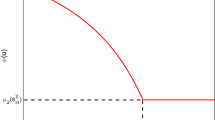Abstract
The steady-state behavior of the Anaerobic Digestion Model No. 1 (ADM1) with respect to dilution rate and substrate concentration is analyzed in this study. Thereby, up to ten coexisting steady-state solutions are observed under the same operating conditions. The parameter region of a methane producing operation is limited regarding high dilution rates as well as low or high substrate concentrations. The underlying mechanisms causing those limits are investigated in detail, and the common core is identified, namely a positive feedback loop between growth of acetate degraders and acetate itself. The difference lies in the activation mechanisms of this feedback loop, which differs in the three investigated cases.
The comparison of the present results with literature studies of simpler two-step models reveals qualitative differences regarding the substrate concentration. Therefore, an alternative simplified model is suggested, which shows qualitatively the same bifurcation behavior as the ADM1 considering variation of the substrate concentration.










Similar content being viewed by others
References
Bailey, J.E., Ollis, D.F.: Biochemical Engineering Fundamentals, 2nd edn. McGraw-Hill Chemical Engineering Series. McGraw-Hill, New York (1986)
Batstone, D.J., Keller, J., Angelidaki, I., Kalyuzhnyi, S.V., Pavlostathis, S.G., Rozzi, A., Sanders, W.T.M., Siegrist, H., Vavilin, V.A.: The Iwa Anaerobic Digestion Model No 1 (ADM1). Water Sci. Technol. 45(10), 65–73 (2002)
Batstone, D.J., Keller, J., Steyer, J.P.: A review of adm1 extensions, applications, and analysis: 2002–2005. Water Sci. Technol. 54(4), 1–10 (2006)
Bernard, O., Hadj-Sadok, Z., Dochain, D., Genovesi, A., Steyer, J.P.: Dynamical model development and parameter identification for an anaerobic wastewater treatment process. Biotechnol. Bioeng. 75(4), 424–438 (2001)
Blumensaat, F., Keller, J.: Modelling of two-stage anaerobic digestion using the iwa anaerobic digestion model no. 1 (adm1). Water Res. 39(1), 171–183 (2005)
Dhooge, A., Govaerts, W., Kuznetsov, Y.A.: Matcont: a Matlab package for numerical bifurcation analysis of odes. ACM Trans. Math. Softw. 29(2), 141–164 (2003)
Droste, P., Miebach, S., Niedenführ, S., Wiechert, W., Nöh, K.: Visualizing multi-omics data in metabolic networks with the software omix—a case study. Biosystems 105(2), 154–161 (2011)
Galí, A., Benabdallah, T., Astals, S., Mata-Alvarez, J.: Modified version of adm1 model for agro-waste application. Bioresour. Technol. 100(11), 2783–2790 (2009)
de Gracia, M., Sancho, L., Garcia-Heras, J.L., Vanrolleghem, P., Ayesa, E.: Mass and charge conservation check in dynamic models: application to the new adm1 model. Water Sci. Technol. 53(1), 225–240 (2006)
Klocke, M., Mahnert, P., Mundt, K., Souidi, K., Linke, B.: Microbial community analysis of a biogas-producing completely stirred tank reactor fed continuously with fodder beet silage as mono-substrate. Syst. Appl. Microbiol. 30(2), 139–151 (2007)
Koch, K., Lubken, M., Gehring, T., Wichern, M., Horn, H.: Biogas from grass silage—measurements and modeling with adm1. Bioresour. Technol. 101(21), 8158–8165 (2010)
Lyberatos, G., Pullammanappallil, P.C.: Anaerobic digestion in suspended growth bioreactors. In: Wang, L.K., Ivanov, V., Tay, J.H. (eds.) Environmental Biotechnology, Handbook of Environmental Engineering, vol. 10, pp. 395–438. Humana Press, Clifton (2010)
Marsili-Libelli, S., Beni, S.: Shock load modelling in the anaerobic digestion process. Ecol. Model. 84(1–3), 215–232 (1996)
Rincon, A., Angulo, F.O.G.: Control of an anaerobic digester through normal form of fold bifurcation. J. Process Control 19(8), 1355–1367 (2009)
Sbarciog, M., Loccufier, M., Noldus, E.: Determination of appropriate operating strategies for anaerobic digestion systems. Biochem. Eng. J. 51(3), 180–188 (2010)
Shen, S.W., Premier, G.C., Guwy, A., Dinsdale, R.: Bifurcation and stability analysis of an anaerobic digestion model. Nonlinear Dyn. 48(4), 391–408 (2007)
Tomei, M.C., Braguglia, C.M., Cento, G., Mininni, G.: Modeling of anaerobic digestion of sludge. Crit. Rev. Environ. Sci. Technol. 39(12), 1003–1051 (2009)
Volcke, E.I.P., Sbarciog, M., Noldus, E.J.L., De Baets, B., Loccufier, M.: Steady state multiplicity of two-step biological conversion systems with general kinetics. Math. Biosci. 228(2), 160–170 (2010)
Wei, C., Chen, L.: Dynamic analysis of mathematical model of ethanol fermentation with gas stripping. Nonlinear Dyn. 57(1–2), 13–23 (2009)
Zhao, Z., Yang, L., Chen, L.: Bifurcation and chaos of biochemical reaction model with impulsive perturbations. Nonlinear Dyn. 63(4), 521–535 (2011)
Acknowledgements
This work was funded by the Federal State of Saxony-Anhalt under the grant Green-FC (6003398800).
Author information
Authors and Affiliations
Corresponding author
Appendix: Monod type model
Appendix: Monod type model
A simple biochemical model for a one-step reaction in a CSTR can be described as follows:


S is the substrate concentration and X the concentration of the microbial biomass. D is the dilution rate, Y the yield coefficient, and μ the specific growth rate, which is given by a Monod kinetic as follows:

μ max is the maximal growth rate and k S the saturation constant.
The steady-states of this model can be derived analytically and are given by


The first steady-state (Eq. (25)) is the desired one, since in the second one (Eq. (26)) no microbial biomass is present and the substrate is not converted. From the equations, for the first steady-state it can be seen that the substrate concentration S depends only on the dilution rate and the kinetic parameters, but not on the inlet concentration S in. If the inlet concentration is changed, only the concentration of the microbial biomass X is influenced.
Another aspect that becomes clear at this simple model, is the region of validity of the first steady-state (Eq. (25)). Since the concentrations should be positive, for a given dilution rate, the inlet concentration has to be larger than the corresponding substrate concentration.

This fact can be seen from a biochemical point of view, also. If the inlet concentration of the substrate is too low, the maintenance metabolism of the microbial biomass is not sufficiently supplied with nutrients.
Furthermore, the dilution rate has to be chosen beneath a certain limit, such that \(S_{\mathrm {ss,1}}\) is larger than zero.

The second steady-state (Eq. (26)) is valid for the whole parameter region, but it is obviously not desired.
Rights and permissions
About this article
Cite this article
Bornhöft, A., Hanke-Rauschenbach, R. & Sundmacher, K. Steady-state analysis of the Anaerobic Digestion Model No. 1 (ADM1). Nonlinear Dyn 73, 535–549 (2013). https://doi.org/10.1007/s11071-013-0807-x
Received:
Accepted:
Published:
Issue Date:
DOI: https://doi.org/10.1007/s11071-013-0807-x




